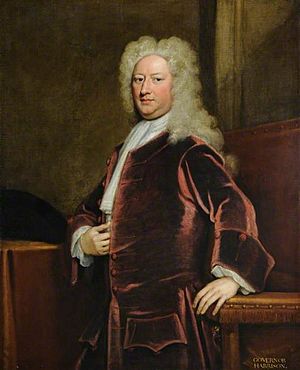Edward Harrison (British administrator) facts for kids
Quick facts for kids
Edward Harrison
|
|
|---|---|

Portrait by Godfrey Kneller
|
|
| President of Fort St George (Madras) | |
| In office 11 July 1711 – 8 January 1717 |
|
| Preceded by | William Fraser (acting) |
| Succeeded by | Joseph Collett |
| Personal details | |
| Born | 3 December 1674 |
| Died | 28 November 1732 |
| Spouse | Frances Bray (1674–1752) |
| Children | Audrey Ethelreda Harrison |
| Signature | |
Edward Harrison (born 1674, died 1732) was an important British official. He worked for the East India Company, which was a powerful trading company. He was also a politician in England. From 1711 to 1717, he was the President of Madras (now Chennai) in India. This was a very important job!
Contents
Edward Harrison's Early Life
Edward Harrison was born in England. His parents were Richard Harrison and Audrey Villiers. He first went to India as a purser, which is like a ship's officer in charge of money and supplies.
Later, he became a captain of ships. These ships traded with China for the East India Company. He commanded the ship Gosfright in 1701 and the Kent in 1709. Before 1708, he married Frances Bray. Her brothers, Edmund and William Bray, were also Members of Parliament.
Leading Madras: Harrison's Time as President
Edward Harrison became the Governor and Commander in Chief of the Madras Presidency in 1711. During his time, he worked on rebuilding the settlement of Madras. He also handled several important situations. One of these was putting down a small rebellion. The East India Company even gave him a special sword to honor his work!
War with Gingee Kingdom
The kingdom of Gingee was ruled by Swaroop Singh. He had declared himself a Raja, or king. The British at Fort St David sometimes didn't pay their rent to him. One time, Swaroop Singh captured two British officers because of this.
Things got really tense in February 1711. Fighting broke out between Gingee and the British at Fort St David. Some officers from both sides were killed. Harrison sent Richard Raworth, an officer from Fort St George, with three ships to help.
Raworth arrived at Fort St David, which was surrounded by Swaroop Singh's forces. Raworth's troops fought against 400 cavalry and 1,000 foot soldiers. They managed to hold their ground, but many Company soldiers were lost. Harrison tried to get help from the Nawab of Carnatic, but it didn't work.
Richard Raworth became the deputy Governor at Fort St David. He tried to make peace with the Raja of Gingee. The Raja asked for 16,000 pagodas (a type of money) as payment for the war. In return, he promised to give up three villages. However, fighting started again in January 1712.
The war finally ended in April 1712. A French Governor from Pondicherry helped them make peace. Swaroop Singh agreed to a settlement for 12,000 pagodas. Later, in 1714, Gingee was taken over by the forces of Carnatic.
Setting Up Postal Service
During Edward Harrison's time, a postal service was created. This service connected the British trading posts in Madras and Calcutta. It was the first postal system set up by the British East India Company in India! Mail was carried by runners, called Tappy peons. They would travel to Ganjam and exchange mail with runners from Calcutta.
Building the Armenian Church
The Armenian church was built in Armenian Street in 1712. This church was important for the Armenian community in Madras. They were a powerful group of traders and merchants.
Richard Raworth's Rebellion
In October 1713, Richard Raworth, who was the Deputy Governor of Fort St David, rebelled. He stopped following orders from Fort St George. Harrison quickly sent a small force to take over Fort St David and remove Raworth. Henry Davenport was put in charge as the temporary Deputy Governor.
The force reached Fort St David in October 1713. They surrounded Raworth and cut off his supplies. Raworth finally agreed to a settlement in December 1713. With help from the French in Pondicherry, Raworth was pardoned. He was allowed to go to France.
Dealing with Caste Problems in Madras
In late 1716, problems between different social groups, or castes, started in Madras. These problems affected daily life and trade in the city. The trouble began when a man from the Komati caste worshipped an idol of a god. This god was usually worshipped by the Chetties, who belonged to a different caste group.
The immediate problem was solved quickly. However, tensions remained, and fighting would start again easily. These ongoing caste conflicts even caused painters in Triplicane to leave the area. Because the disputes continued and threatened the city, Harrison was called back to England. Joseph Collett took his place as President.
Edward Harrison's Later Life
When Edward Harrison returned to England, he became a Member of Parliament (MP). He represented the area of Weymouth and Melcombe Regis starting in 1717. He also became a Director of the East India Company in 1718 and stayed in that role until 1731.
In 1722, he switched to represent Hertford in Parliament. He was also the deputy chairman of the East India Company in 1723. In 1726, his father passed away, and Edward inherited Balls Park, a large estate. He then left his MP seat in Hertford for his brother George. This was because he was appointed Postmaster-General in 1726. He continued to be involved with the East India Company, serving as deputy chairman again in 1728 and chairman in 1729.
Edward Harrison died on November 28, 1732. He and his wife, Frances Bray, had one son and three daughters. One of his daughters, Audrey "Etheldreda" Harrison, married Charles Townshend in 1723.
See also
- Governors of Madras


